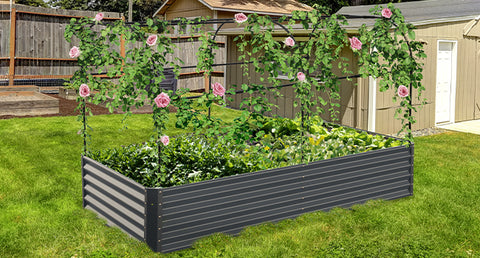Elevated POTS make almost any plant easier to grow. You can create your own in a few simple steps.A raised bed can solve a variety of garden problems, especially if you have hard, poor soil in your yard. Instead of trying to dig a new garden bed in the ground, an elevated bed lets you go above and beyond. The following content also has some reference value for raised garden beds.
In addition to fewer weeds, planting on a raised bed avoids bending and kneeling, whereas gardening on a regular bed can make gardening feel like a lot of work. Another benefit of garden beds: The soil warms up faster in the spring, so you can plant more quickly and run off more quickly in wet weather. While you can buy a large number of loft bed kits, it's not too difficult to make your own loft bed from a few pieces of wood.

What do you need?
- Harrow
- Level
- (4)1 foot long 4x4s
- (8) 4ft long 2x6s
- (4)2 feet long 2x2s
- Drill
- Screws
- Square
- Tape measure
- Shovel
- Deck screws
- topsoil
Step 1: Mark the frame of the flower bed
Start by determining how big you want your garden bed frame to be. If you're not sure, start with a 4x4 foot garden bed frame; It's big enough for a variety of plants, but small enough that you can still reach the center of the bed. Rake the ground to level your seedbed.
Step 2: Make the garden bed frame wall
First, four foot-long 4x4s serve as corner posts; Eight 4ft long 2x6 railings; There are also four 2x2s of 2-foot-long middle stakes (you can buy stakes of this size from your local hardware store, or cut them to size as needed).
4x4s are placed at each corner of the square to form garden bed frames. Then pick a wall to start with and screw the first 2x6 to the raised bed corner. Put the second 2x6 on top of the first. The ends of the 2x6 plate should be even with the sides of the post. Use a square to ensure that the track and post line up at right angles.
Step 3: Connect the garden bed frame wall
Erect the side walls of the garden bed frame against each other, with the pillars on the outside. Screw two side rails onto the posts to create a bump for the rest of the wall. Again, the end of the rail should be even with the side of the post.
A three-season bounty bed garden program
Step 4: Straighten the frame of the flower bed
Measure the diagonal of the raised bed in both directions to ensure that the frame is square. Then, adjust the raised bed until the two diagonal lines are equal in length.
Step 5: Make the garden bed frame strong
Take a 2x2 stake and place it at the halfway point of the outer wall of the garden bed frame. Dig or drive the stake into the ground so that the top of the stake is flush with the top of the side rail. Attach the stakes to the raised bedside rail with deck screws ($37 at Home Depot). Repeat with the remaining three garden bed framing walls.
Step 6: Fill the garden bed frame with dirt
Once you've built your garden bed, fill the frame with topsoil. If you wish, improve the soil with lots of organic matter, such as compost or peat moss. Water the bed well and you're ready to plant!

8 Bed Gardening Mistakes That Could Be Holding You back from Success
How you build and maintain your space for growth will affect your success. Here are a few things to avoid so you can increase your backyard bounty.
Planning a raised bed garden always starts with a lot of commitment. These elevated growing Spaces have several benefits over underground gardens, such as easier access, easier control of soil composition, improved drainage, warmer soil temperatures, and the ability to plant earlier and grow faster. So you eagerly dream of how to grow an elevated garden full of fresh vegetables that your kids can eat straight off the vine and cut bold flowers to put on a vase. But in your enthusiasm, it's easy to make some common mistakes that can undermine your efforts. Here are some things to avoid doing so you can get smarter, not harder.
- Picking the wrong place
Your bed should receive at least six hours of direct sunlight a day. If you are in early spring, consider what the surrounding trees will look like in the summer and where their shadows will fall. Choose relatively flat areas, but avoid low-lying areas, such as the base of a hill where rain collects. Leaning a raised bed against a fence or wall means you can't easily access it from all sides.
- You forget water
Your backyard might be a reasonable place to put your raised bed, but if you have to carry a bucket to take care of them. Make sure it is close enough to an outdoor faucet for a garden hose to reach. In addition, you might consider installing a drip irrigation system to keep your bed watered continuously and minimize waste.
- Make your bed too big
While it is tempting to create a large plot, it is crucial to consider logistics when planning how to plant a raised bed garden. Your field should be narrow enough to reach the middle for planting, weeding, watering, and harvesting. Three to five feet wide, the size of most prefabricated kits, is ideal for most people. Avoid writing too long; You don't want to get frustrated when you're walking around in big circles. If you have enough space and desire, you're better off creating multiple smaller raised beds.
6 Tips for Starting your first vegetable Garden
- Build with the wrong materials
Durable, long-lasting pressurized treated wood may seem like a sturdy material if you plan to build a raised bed yourself, but many gardeners prefer to avoid this material because of the risk of harmful chemicals leaching into the soil (same goes for old tires). On the other hand, you also want to avoid wood that is perishable or already showing signs of wear, such as pallets, or that you may need to rebuild within a year. So choose cedar, oak, mahogany, stone, and brick, which are all very good, long-lasting, chemical-free choices.
- Not using the best soil
The bag says garden soil, so it must be suitable for all types of gardens, right? Not so fast. The garden soil is intended to be mixed with existing subsurface topsoil to help improve its texture and nutrient composition. When used on raised beds, it becomes dense and inhibits drainage. Make sure you use bagged soil specifically designed for raising beds, it also has bactericidal benefits and will kill any weed seeds, insects, or diseases.
- Choose oversized plants
When planting within the confines of a raised bed, consider the size you want to plant and the size of maturity to ensure you have room for several varieties. For example, a zucchini will take up the entire two-foot square. If you're tight on space, plant smaller vegetables, choose short varieties, and practice continuous planting.
19 vegetable container garden ideas to show your yield
Step 7 Skip mulch

Even if your garden is off the ground, it still tends to get overgrown with weeds. Be sure to add a layer of mulch to prevent weeds from spreading. Mulch also helps the roots retain water so you don't have to water them as often. Plus, your produce will be cleaner because the mulch keeps rain from splashing soil onto your plants.
- Not protecting your plants
While raised beds may be enough to keep rabbits away, you may just be putting your precious produce at the eye level of a hungry deer.









